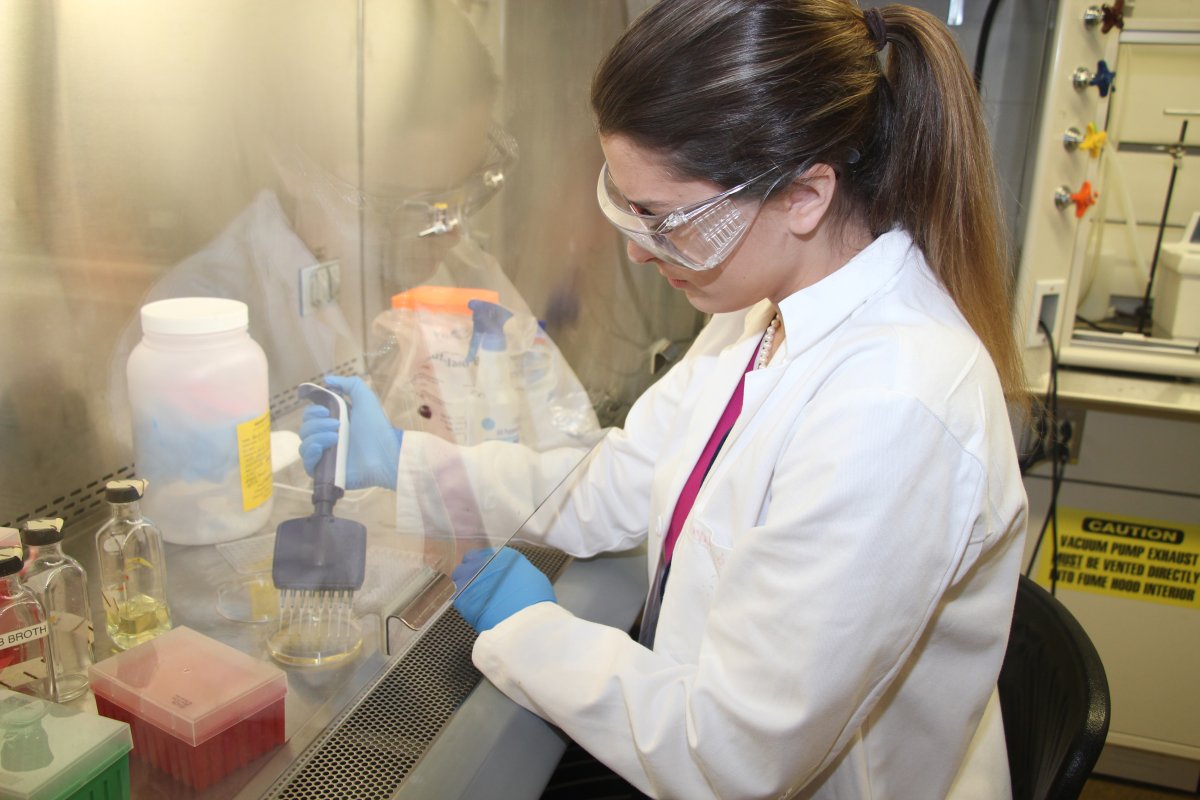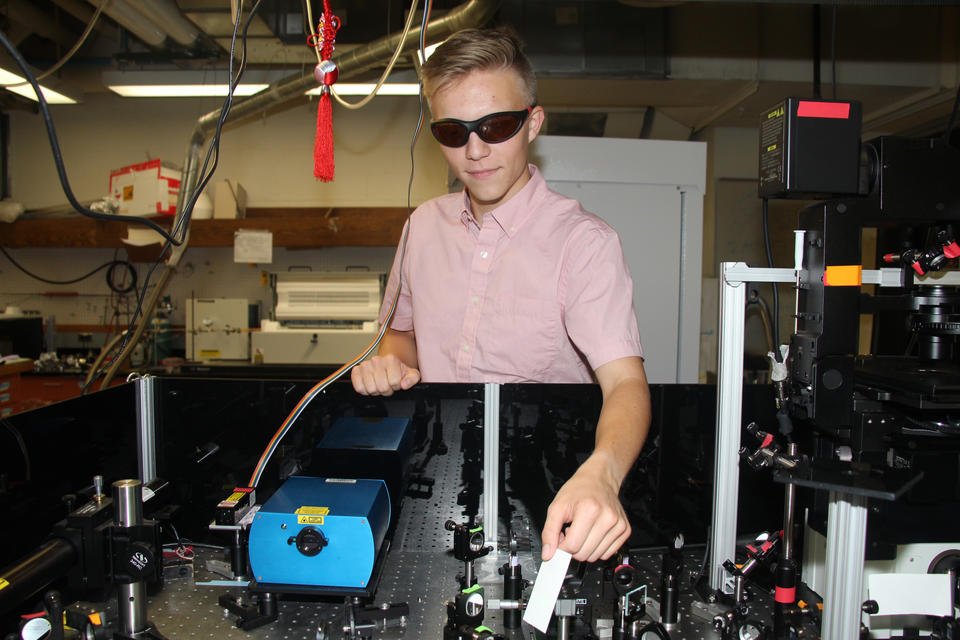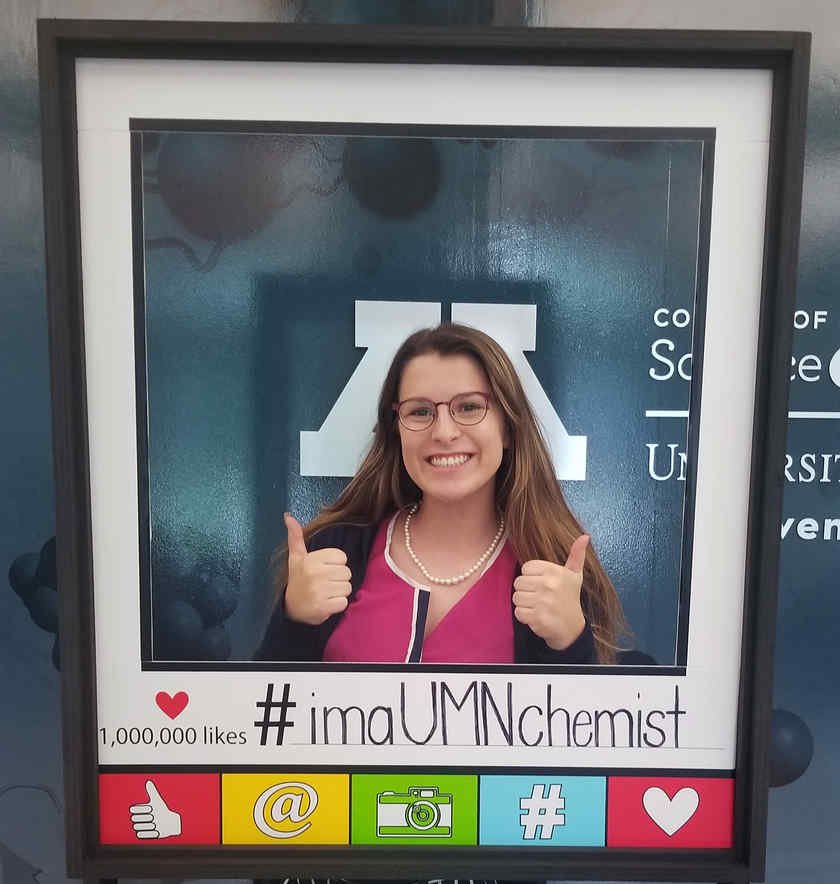Opportunities abound for undergraduate chemistry majors
Our undergraduate chemistry majors are immersed in their studies, embrace research opportunities, and are active participants in the Department of Chemistry and University of Minnesota communities. We feature profiles of two of our outstanding students, Meghan Cahill and Levi Palmer.
Meghan Cahill
Meghan Cahill is from Hanover, MN, and a junior chemistry major with minors in biology and communications. Her research adviser is Professor Christy Haynes, who is associate director of the Center for Sustainable Nanotechnology through which Meghan conducts her research.

How did you become interested in chemistry?
From a young age, I was entirely in love with charts and numbers; My favorite part of trick-or-treating on Halloween was making bar charts in crayon of the different types of candy I received. In fourth grade, after my parents took me to the Soudan Underground Laboratory in Northern Minnesota, I decided that I was going to be an astrophysicist.
I wasn’t interested in chemistry until 9th grade when I took my first chemistry class. I thought the material was really cool, and I had a fantastic teacher that made it easy to get excited about the class. But I still wanted to be an astrophysicist. In 11th grade, I took College Gen Chem 1 and 2. The material came more naturally to me than physics ever did and it all just made so much sense. After I had the opportunity to do a research project in my high school chemistry class investigating the effects of acid rain on bean plants, I recognized my interests were not in space, but much closer to home. So, I decided I was going to be a chemist instead.
How long have you been conducting research?
Research was the only thing I knew I wanted to do in college, so I reached out to some of the chemistry faculty the first week of my freshman year. Professor Christy Haynes offered me a job in her laboratory, and I was able to start working in her lab the first month of my freshman year. I’ve been researching for just over two years.
What are your general research interests, and what is the current research that you are involved with?
As part of the Center for Sustainable Nanotechnology, I study the environmental impacts of nanomaterials. My current project is to examine the toxic effects of nanoparticles used in agricultural applications on bacteria in the environment, while attempting to increase the complexity of the lab conditions to more accurately reflect real environmental conditions. Prior to this project, I was investigating the interactions between the bacterial cell surface and nanomaterials in lithium-ion batteries. I also worked on a chemical education project developing a low-cost macroscale transmission electron microscopy model to help make electron microscopy curriculum more accessible to high schools and primarily undergraduate institutions.
Generally, I have really enjoyed doing bioanalytical chemistry in the Haynes lab, and I expect to continue with that kind of research long term. I enjoy researching sustainability in agriculture, and I hope to eventually also do research with medical applications.
What organizations, committees, etc., are you involved with?
I am involved with the Department of Chemistry’s Diversity and Inclusion Committee as an undergraduate representative. I also sit on the leadership team for the College of Science and Engineering’s Diversity and Inclusion Alliance, where I am co-chair of the education subcommittee. This semester, I’ll be helping Department Chair David Blank plan and organize the department’s fall climate event on implicit bias.
I try to do as much science, technology, energy and math (STEM) outreach as I can through programs like Chemists in the Library, Women in Science & Engineering, and as a volunteer at the Science Museum of Minnesota.
Outside of science, I’m part of the University Honors Program, and a community adviser for the Honors Program Living Learning Community in Middlebrook Hall. I’m also on the advisory committee for the Department of Housing. Recently, I started working for the Minnesota Historical Society as a History Day Mentor where I’ll be helping middle school and high school students research and prepare their projects for the MN History Day competition.
What are the three greatest things from the Department of Chemistry that inspire and motivate you?
- I appreciate how much focus the department has put on diversity and inclusion efforts. As a student with disabilities, I struggled when I started college and almost dropped out of school my first semester. The Chemistry Department has been the most inclusive and welcoming space for me on campus, and I’m incredibly grateful to be a part of it.
- All of the female faculty in the department are absolutely incredible and inspiring, especially my principal investigator, Professor Haynes. I’m lucky to be able to learn from women whom I hope to be like one day. The obstacles and barriers they’ve overcome to get to where they are now make it possible for me to follow in their footsteps, and I’m grateful to be surrounded by all their brilliance. They motivate me to continue to make the sciences accessible to the next generation of scientists.
- Again, this isn’t a thing, but a person. My graduate student mentor, Natalie Hudson-Smith, has been one of the most inspiring and motivating people I’ve met in the department. She pushes me to not only be a better scientist, but also teaches me how to be a better person. She’s taught me how to actually do research and never gets annoyed when I ask a million questions. She’s brilliant, kind, and understanding. Natalie is always willing to go above and beyond to help me, and I wouldn’t be where I am without her. Everyone deserves to have a Natalie in their life.
What are your plans/hopes for the future?
I plan on pursuing a doctorate in chemistry with the goal of becoming a chemistry professor at a research-intensive (R1) institution. I actually hope to come back here to the University of Minnesota to work, so whoever is on the search committee in eight or nine years should expect my application. I would like to have a research program at the interface of chemistry and biology/ecology. One goal of my program will be to research the molecular underpinnings of Parkinson’s disease to help develop treatments and eventually find a cure. Another goal will be to use chemistry to promote sustainability and eco-friendly technology in agriculture.
Awards and Scholarships
Meghan has received a Presidential Scholarship Award, Thomas DuBruil Memorial Award, Lloyd W. Goerke Scholarship, Heisig-Gleysteen Summer Research Fellowship, and an Undergraduate Research Opportunities Award (UROP) award. Her first research paper, on which she was the second author, was published in June in the Journal of Chemical Education. Her second research paper was published in August in Chemical Science.

Levi Palmer
Levi Palmer is from Pequot Lakes, MN, and graduated in the spring of 2020. His research adviser was Professor Renee Frontiera.
How did you become interested in chemistry?
I originally came to the University of Minnesota to study chemical engineering with a possible focus in biological engineering. I really wasn’t sure what I wanted to do; however, I was interested in several themes that focused on preserving the environment. As a child, I said it was my goal to stop climate change. During my senior year of high school, I was considering paths ranging from pharmacology to environmental engineering. What I didn’t know was that I would quickly become interested in chemistry.
My first semester at our institution was a culture shock. I loved the city and the campus, but everything was busier, more accepting, and more diverse. My courses were more challenging than what I had prepared for, and nothing was handed to us as college students. Professor Kenneth Leopold’s general chemistry course was the only science, technology, engineering and math (STEM) course that I could fully comprehend. It helped me feel grounded. For that reason, I was encouraged to continue on a path toward chemical engineering.
Professor Renee Frontiera provided immense encouragement to pursue a double major in chemistry upon joining her lab. My sophomore year of college was filled with doubts about what I wanted out of my career. After increasingly enjoying the excitement and possibilities of spectroscopy and talking with nearly every peer and professional, I decided to drop chemical engineering and pursue a focus on physical chemistry. This enabled me to design my own schedule that allowed for courses in materials science, chemical engineering, physics, and chemistry. I’m even taking courses in public policy to gain additional experience. A degree in chemistry allows me to remain excited about our scientific field while being actively engaged with my community.
How long have you been conducting research and who is your adviser?
I began research during spring break of freshman year with Professor Frontiera. I will have worked with her for more than three years upon graduation. I also partake in research works with Professor Gabriel Chan in the Humphrey School of Public Affairs: I began this work in June 2019.
What are your general research interests, and what is the current research that you are involved with?
My largest motivation is the environment. I want to know and understand how we can mitigate climate change to preserve the future of Earth. I am interested in many different fields and research questions. Although it is challenging to manage my time with so many interests, one of my skills is knowing and understanding how these interests relate and how we can investigate these relationships using spectroscopy. I love being a spectroscopist because it allows me to investigate a multitude of materials. It is my goal to focus on studying photonic, plasmonic, and electrochemical systems with spectroscopic methods. If we can assess these systems on ultrafast timescales, we will be able to design advanced photocatalysts, photovoltaics, and quantum computers.
I am also interested in working with policy because I want to directly impact my community. There is a growing divide between scientists and the public. I believe that we are on a path to bridge that divide with more accessible science, and it is my goal to support this growth. As chemists, we are trained to know how much of the natural world works while being equipped with immense analytical skills. This provides us with the ability to influence major political systems in society.
Physical and Materials Chemistry: I use spectroscopy to probe the interaction of materials with their unique environments. My undergraduate research has primarily involved the use of Raman spectroscopy as a probe of plasmonic materials. Plasmonic materials are often metal nanostructures (like gold nanoparticles) that contain a free electron density that can be excited by incident electromagnetic radiation. When the electrons oscillate at a frequency that is dependent on the nanostructure’s dimensions and composition, light can be localized to the nanoscale. This enhances the detection of molecular vibrations in Raman spectroscopy or it can be used for plasmon-driven chemical reactions.
My first research endeavor in the Frontiera Lab applied plasmonic materials to photonic crystals. Photonic crystals contain alternating layers of high and low refractive indices which allows only specific energies of radiation to propagate through the structure, while others are scattered to the far field. This is interesting for applications like photocatalysis. If we could selectively excite a catalyst with one energy of light, we could potentially drive more specific photocatalytic reactions or use the constructive nature of the photonic crystal to improve existing reactions. In our study, we deposited silver nanoparticles and a molecular analyte on butterfly wings of different colors and measured the resulting Raman spectra. Because butterfly wings receive much of their color from photonic crystals, we could use the wings as a cheap and effective photonic crystal without complex materials fabrication. We compared how the color of the butterfly wing and wavelength of Raman (laser) excitation affect the measured Raman signal. Our hypothesis was confirmed when we observed the largest Raman scattering when the laser excitation and photonic crystal had paired color combinations. This work resulted in the submission of a publication to the Journal of Materials Chemistry C this spring.
My current work in the Frontiera lab is using surface-enhanced Raman spectroscopy to assess the interaction between chiral plasmonic nanostructures and molecules. This work is motivated by plasmon-driven photocatalytic reactions that can potentially be enantioselective. If our hypotheses are supported, we could use chiral plasmonic materials to design drugs or even create materials for advanced immunotherapies. I have designed the system to test our chiral plasmonic materials, but I have yet to optimize the experiment to reveal key information about the molecules we are testing.
Environmental Policy: Although new to policy, I am broadly investigating the application and models of community solar for Minnesota and low-income communities. Community solar often operates on a buy-in principle. This involves a utility owning a solar farm on buildings like schools or churches or on landfills, and local residents are given the option to purchase renewable energy from the utility. Our main focus is to work with organizations around the United States who have already established working models of community solar. We would ideally use this information to design platforms for energy consumers and utilities to more efficiently use/provide renewable energy.
What organizations, committees, etc., are you involved with?
I lead a group called Critical Analysis of Scientific Literature (CASL). We are funded by the Chemistry Department, and we meet biweekly to discuss all topics of science literature published on our campus. We invite faculty to speak, and we host workshops for science writing and advancement.
I am a member of the chemical engineering car team with the American Institute of Chemical Engineers. We design a model car, driven by a chemical reaction, for competition at the organization’s regional conferences.
I am also a member of the Minnesota Student Association, one of the student government body’s on campus. Although formerly a fellow of the student representatives to the Board of Regents, I look to being active on the group’s sustainability committee. One of the biggest political challenges in environmental policy is setting a precedence for clean energy. Affiliates of the Institute on the Environment at the University of Minnesota are advocating for clean energy goals at the state level, and I am looking to create a team that connects UMN students and Minnesota residents with their congressional representatives to advance the conversation of clean energy.
This past semester, I worked with a team of UMN students to draft a Student Senate and Minnesota Student Association resolution that is looking to establish a task force of students, staff, and faculty. The purpose of the task force would be to design a platform for the University of Minnesota to show the state that it can set a goal for 100 percent clean or renewably generated electricity by 2050. It would display the plethora of research works we have accomplished and use the platform our Director of Sustainability, Shane Stennes, has designed.
What are the three greatest things from the Department of Chemistry that inspire and motivate you?
- We are the most inclusive department I have ever seen, which is really encouraging for students of marginalized identities. I have learned so much from our department and our faculty, which further inspires me to be an Ally myself.
- Undergraduate students are given academic freedom to pursue cutting-edge research topics. My friends and I have been able to lead with a curious mind and advance the work of our field.
- We have a legacy of alumni that connects me to faculty and professionals around the world. The Department of Chemistry opens many doors for my professional future and supports current students with financial support via aid from alumni and family donors.
What are your plans/hopes for the future?
It is my eventual goal to be a professor at a Research Intensive (R1) university. Unfortunately, it is very clear that faculty positions at such elite schools are difficult to attain. Furthermore, it is my hope to live in Minnesota due to family location. Although location is a major constraint for faculty employment, I know I would also be happy working in many careers from industry to politics. To reach professorship, I plan to complete a doctorate in physical chemistry.
Awards and scholarships
Some of the honors and awards Levi has received include the David A. and Merece H. Johnson Scholarship, American Chemical Association I.M. Kolthoff Enrichment Award, Amgen Scholarship, College of Science and Engineering Merit Scholarship, Lloyd W. Goerke Scholarship, Professor Gary R. & Natalie W. Gray Chemistry Undergraduate Summer Research Scholarship, and Astronaut Scholarship nomination.

